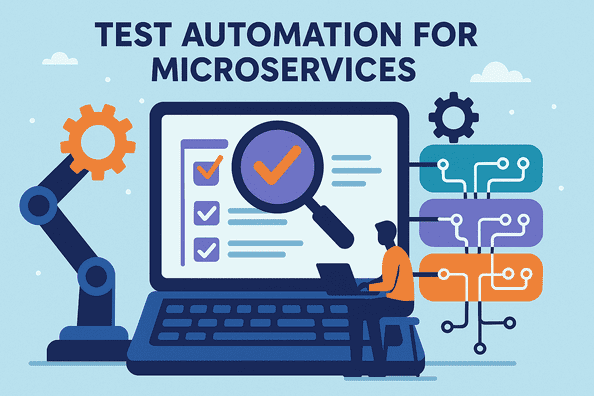Microservices architecture has revolutionized software development by breaking applications into smaller, independent services that can be developed, deployed, and scaled individually. While microservices offer flexibility and faster delivery, they also introduce new challenges for quality assurance (QA) and testing.
Test automation is essential in microservices environments to ensure reliability, performance, and seamless integration across distributed services. Without robust automated testing, teams risk introducing defects, regression issues, and deployment failures that can affect production systems.
In this article, we explore strategies, best practices, and tools for effective test automation in microservices-based architectures.
Why Test Automation Is Critical for Microservices
Unlike monolithic applications, microservices involve multiple services that interact through APIs and messaging systems. Manual testing alone is insufficient due to:
- High complexity of service interactions
- Frequent deployments and continuous delivery pipelines
- Dependencies across distributed services
- Need for rapid feedback in CI/CD pipelines
Test automation addresses these challenges by enabling:
- Continuous testing during development and deployment
- Rapid validation of individual services and their integrations
- Early detection of regressions and defects
- Reliable and repeatable test execution
Automating tests for microservices ensures that teams maintain service quality while accelerating release cycles.
Strategies for Test Automation in Microservices
1. Service-Level Testing
Focus on individual microservices first. Validate each service’s functionality, endpoints, and business logic through automated unit and API tests.
Best practices:
- Use lightweight testing frameworks for unit tests
- Validate API contracts with tools that support contract testing
- Automate database and integration tests where relevant
2. Integration Testing
Integration testing ensures that services work together as expected. In microservices, interactions between multiple services can introduce failures that unit tests alone cannot catch.
Best practices:
- Use stub or mock services to simulate dependencies
- Automate integration scenarios covering real-world workflows
- Continuously run integration tests in CI/CD pipelines
3. Contract Testing
Contract testing verifies that service interfaces adhere to agreed specifications, preventing downstream failures. This is critical when services evolve independently.
Best practices:
- Use consumer-driven contract testing frameworks to validate expectations
- Integrate contract tests into pipelines to catch breaking changes early
- Maintain contracts alongside service code for version control
4. End-to-End Testing
End-to-end tests validate complete user workflows across multiple services. While necessary, they should be used sparingly because they can be time-consuming.
Best practices:
- Automate only critical workflows to balance coverage and execution time
- Use service virtualization to simulate unavailable or costly services
- Ensure tests are repeatable and maintainable across environments
5. Performance and Load Testing
Microservices must handle variable traffic and maintain response times. Automated performance tests identify bottlenecks and ensure scalability.
Best practices:
- Test services individually and as part of full workflows
- Use automated load testing tools to simulate realistic traffic patterns
- Monitor performance metrics continuously for regression detection
Tools for Test Automation in Microservices
Several tools are particularly suited for testing microservices and automating different layers of testing:
- Keploy – AI-driven automated test generation for APIs, ideal for validating microservice endpoints and service interactions
- REST-assured – Java-based framework for automating API tests, including functional and integration testing
- Postman & Newman – Open source tools for API testing and automated test execution in CI/CD pipelines
- Pact – Consumer-driven contract testing tool to ensure services meet contract expectations
- JMeter – Open source tool for performance testing and load simulation across microservices
- Selenium + Cypress – Useful for end-to-end testing of front-end workflows interacting with microservices
Selecting the right combination of tools ensures comprehensive coverage, from unit and API tests to performance and end-to-end workflows.
Best Practices for Test Automation in Microservices
- Shift-Left Testing: Integrate automation early in the development process to catch defects sooner
- Continuous Testing: Embed automated tests in CI/CD pipelines to provide instant feedback for every build
- Test Data Management: Use realistic datasets while isolating test environments to prevent cross-service interference
- Monitoring and Observability: Combine automated tests with logs and metrics to detect issues proactively
- Scalable Test Architecture: Design test suites that can handle the growth of services and increased test coverage without slowing down pipelines
Challenges and How to Overcome Them
- Service Dependencies: Use mocks, stubs, and virtual services to decouple tests
- Test Maintenance: Continuously review and refactor tests to reduce flakiness
- Complexity in CI/CD: Automate deployment and environment provisioning to maintain reliable pipelines
- Data Consistency: Automate database seeding and cleanup to ensure test reliability
By addressing these challenges proactively, teams can maintain high-quality microservices and smooth automation workflows.
Conclusion
Test automation is critical for modern microservices architectures, enabling teams to ensure quality, reliability, and performance in complex distributed systems. By combining service-level testing, integration testing, contract validation, end-to-end workflows, and performance testing with the right tools, QA teams can achieve faster releases and reduce production defects.
In 2026, effective microservices testing will rely on a combination of AI-driven automation, CI/CD integration, and smart test strategies to maintain efficiency and scalability. Organizations that adopt these practices will be better positioned to deliver robust, resilient, and high-performing microservices applications.
